At Shao (哨) level, the formations of Xu Guang Qi (徐光啟) became even more complex. A Shao consisted of five Dui (隊) and four support personnels, led by a Shao Zong (哨總).
Fang Shao (方哨, square company)
The formation could be formed from either Fang Wu (方伍), Yuan Yang Wu (鴛鴦伍) or Yi Zi Ping Wu (一字平伍). It occupied a space of fifty by fifty chi.
Yuan Shao (圓哨, round company)
 |
| Layout of a Yuan Shao, from 'Xuan Lian Tiao Ge (《選練条格》)'. |
Qu Shao (曲哨, crooked company)
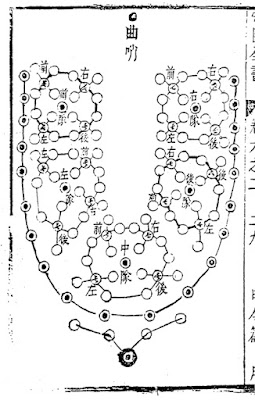 |
| Layout of a Qu Shao, from 'Xuan Lian Tiao Ge (《選練条格》)'. |
As this formation was designed to flank enemy unit from both sides, it did not occupy a fixed area.
Zhi Shao (直哨, straight company)
 |
| Layout of a Zhi Shao formed from Fang Wu, from 'Xuan Lian Tiao Ge (《選練条格》)'. Unlike Yuan Yang Wu version of Zhi Shao, all porters followed closely behind Fang Wu. |
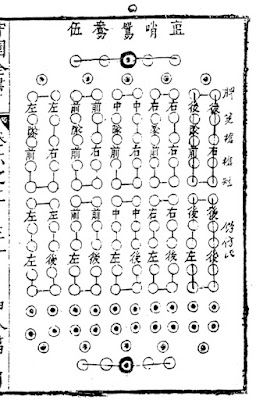 |
| Layout of a Zhi Shao formed from Yuan Yang Wu, from 'Xuan Lian Tiao Ge (《選練条格》)'. The porters were positioned behind the formation. |
Like Zhi Dui, the company leader could position himself at the front or at the back of the formation.
Rui Shao (銳哨, sharp company)
Rui Shao was the rhombic or wedge formation for Shao-level tactical unit. It was formed form a mixture of Er Zi Ping Wu at the outer layer and Zhi Wu (直伍) at the inner layer. Xu Guang Qi designed three variations of Rui Shao suited for different purposes, but did not elaborate on their functions. However, the purpose of two out of three formations can be guessed easily enough based on their names.
Tu Wei Shi (突圍勢, lit. 'Breakout form')
 |
| Layout of a Rui Shao in Tu Wei Shi formation, from 'Xuan Lian Tiao Ge (《選練条格》)'. |
Kui Di Shi (潰敵勢, lit. 'Enemy-routing form')
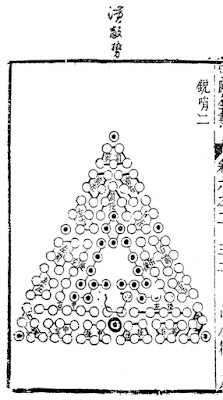 |
| Layout of a Rui Shao in Kui Di Shi formation, from 'Xuan Lian Tiao Ge (《選練条格》)'. |
Fen He Shi (分合勢, 'Divide and regroup form')
 |
| Layout of a Rui Shao in Fen He Shi formation, from 'Xuan Lian Tiao Ge (《選練条格》)'. |
EXTRA: Xu Guang Qi's Yuan Yang Wu (鴛鴦伍)
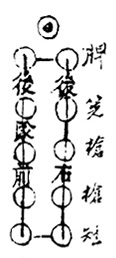 |
| Xu Guang Qi's Yuan Yuan Yang Wu. This image is cropped from Zhi Shao section of 'Xuan Lian Tiao Ge (《選練条格》)'. |
Tang Shun Zhi (唐順之) and Qi Ji Guang (戚繼光) version of Mandarin Duck Formation. It even resembled the Shield formation of Luo Gong Chen (羅拱辰) somewhat. The formation consisted of two identical Wu (伍) supported by one porter, armed with two Ai Pai (挨牌), two Lang Xian (狼筅), four Chang Qiang (長鎗) and two or four polearms (Xu Guang Qi did not specify whether his shieldmen were armed or not, although all troopers were armed in every other instance). Every trooper in Xu Guang Qi's army also served as arquebusier and/or archer.
Unlike Qi Ji Guang's version, Xu Guang Qi did not employ dedicated swordsmen (although sabres were issued as sidearm to every troop) and rockets. His formation also did not have squad-level leader, as the two Mandarin Duck Teams were led by one platoon leader instead. Lang Xian, instead of shieldmen, were team leaders.
Other blog posts in my De Sheng Bing series:
Xu Guang Qi's De Sheng Bing — Part 1
Xu Guang Qi's De Sheng Bing — Part 2
Xu Guang Qi's De Sheng Bing — Part 3-1
Xu Guang Qi's De Sheng Bing — Part 3-2
Xu Guang Qi's De Sheng Bing — Part 4
Xu Guang Qi's De Sheng Bing — Part 5

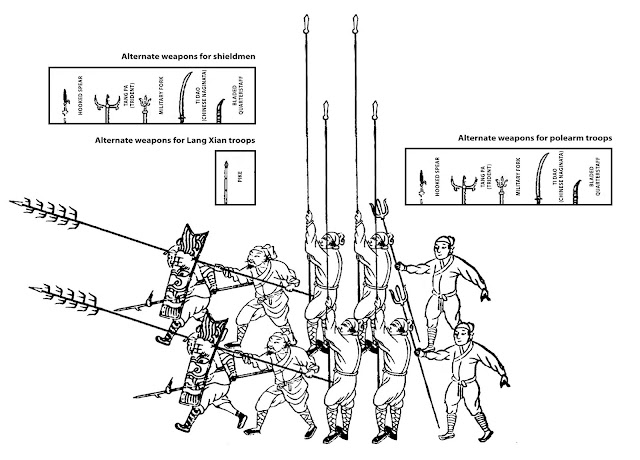
No comments:
Post a Comment